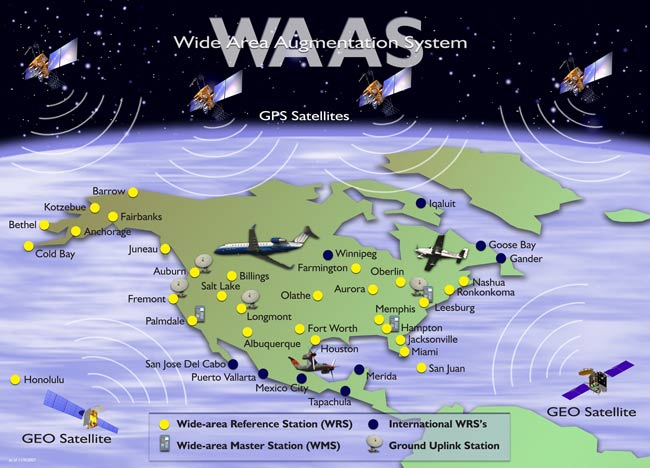New System Makes Bad-Weather Flying Easier for Pilots

A recentlyinstalled FAA navigation system called the Wide Area Augmentation System (WAAS)is making life much easier for general-aviation pilots in the United States, particularly when trying to land at small airports in bad weather.
Pilotsflying aircraft equipped with the latest Global Positioning System (GPS)equipment in the continental U.S. and much of Canada and Mexico are now able to pinpoint their location to within 25 feet, thanks to WAAS.
WAAS is a networkof 39 precisely surveyed groundreference stations located across the U.S. and in parts of Canada and Mexico. The system also involves two master stations, one each on the west and east coasts,and three data uplink stations.
Groundreference stations in the WAAS network collect GPS satellite data and developmessages to correct any signal errors, which are caused by ionosphere disturbancesand timing and satellite orbit errors.
These correctionmessages are broadcast through communication satellites to GPS receivers onaircraft, ships, and land vehicles equipped with a WAAS-GPS receiver. WAAS alsoprovides GPS-satellite-integrity information to the U.S. Air Force 50th SpaceWing, which manages the satellite constellation.
TheGlobal Positioning System
The GlobalPositioning System comprises 31 satellites circling the earth at a medium orbitof approximately 12,660 miles. The satellites transmit signals to GPS receiversthat have become common in aircraft, maritime vessels, and land vehicles. Certaintypes of cell phones and watches also have a GPSreceiver.
Get the Space.com Newsletter
Breaking space news, the latest updates on rocket launches, skywatching events and more!
Using the datatransmitted via microwave signals from the satellites, GPS receivers determine theirlocation, speed, and direction, and display the information to users. The satellitesignal also includes the precise time.
Non-WAASGPS receivers provide positional fixes accurate to within approximately 50feet. In aircraft, such receivers do not provide vertical guidance to pilotsflying instrument approaches.
But WAASprovides the additional accuracy, integrity, and availability required tonavigate using GPS for all phases of flight, from enroute flying to instrument approachesat qualified airports within the WAAS coverage area.
Because ofthis, prominent aviation organizations such as the NationalBusiness Aviation Association and the Aircraft Owners and PilotsAssociation (AOPA) have been strong supporters of WAAS.
?We haveurged both Congress and the FAA topress ahead with the program because it improves air safety by providing theprecision vertical guidance needed, especially in poor weatherconditions," said Phil Boyer, president of AOPA, in March 2006. "Andit makes better use of the nation's system of airports, because thousands thatcurrently may only be used in good weather can become all-weather capable.?
Lateralprecision, vertical guidance
WAAS-GPSprovides lateral precision, vertical guidance (LPV) down to 200 feet aboverunways using developed LPV instrument approaches. The advantage of WAAS topilots is that they can fly an instrument approach in poor weather at many moreairports than before, particularly at smaller, general aviation airports. As aresult, WAAS improves the efficiency and capacity of the U.S. National AirspaceSystem.
However, becausesome of the satellites that receive WAAS correction signals are over the equator,GPS-WAAS users in North America who are in mountainous areas may experiencedifficulty receiving the WAAS signal. Until more ground reference stations areinstalled, signal reception is best in open land and marine environments.
The FAA andDepartment of Transportation began developing WAAS in 1994. The system has beenavailable for visual flight rules (VFR) and recreational use since August 2001.In July 2003, WAAS was approved for non-precision aircraft instrumentoperations, and in March 2006, LPV approaches became available. The WAASproject is expected to be completed in 2013, with a final price tag of $3.3billion.
WAASproduces cost savings for FAA
It costs about$50,000 to map and publish a new, WAAS-GPS LPV approach. By comparison, aCategory 1 instrument landing system (ILS), which is comprised of electronicequipment installed at an airport that guides aircraft horizontally and verticallydown to 200 feet above a runway, costs from $1 million to $1.5 million perrunway end.
FAA costsavings are another advantage of WAAS, which allows redundant ground-basednavigation aids to be decommissioned. WAAS also provides a back-up capability inthe event of an ILS outage.
Governmentsof other nations are developing navigation systems similar to WAAS. Japan is working on a Multi-Functional Satellite Augmentation System (MSAS), while Europe isdeveloping the European Geostationary Navigation Overlay Service (EGNOS).
One day, GPS-equippedpilots anywhere in the world will be able to determine their positions preciselyand navigate using WAAS, MSAS, EGNOS, and other compatible systems.
Join our Space Forums to keep talking space on the latest missions, night sky and more! And if you have a news tip, correction or comment, let us know at: community@space.com.









